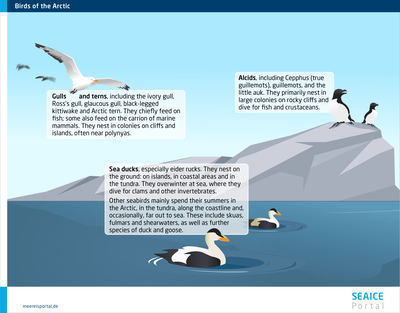Birds
For many marine bird species, the sea ice is an important habitat that interacts with them in a number of ways. Firstly, the ice offers access to the reliable food web connected to its various habitats. Secondly, the sea ice can represent a physical barrier to their food supply. In other words, too much ice, ice in the wrong place, or ice in the right place but at the wrong time, can have grave consequences for seabirds, as they are completely dependent on finding food among the seasonally frozen sea ice. Accordingly, many bird species follow the movement of the sea ice throughout the year. What’s more: the variability of the sea ice has a major influence on their lifecycle. Their migratory routes and breeding seasons, the locations of their colonies, their feeding behaviour, breeding success and population size all depend on the status of the sea ice, its growth or retreat.
The marine avifauna of the Arctic are a diverse collection of species. The region is home to the highest breeding densities for seabirds in the Northern Hemisphere; every spring, millions of birds migrate north to breed (Karnovsky and Gavrilo, 2017).
Whereas there are virtually no land-based birds in the Antarctic, more than 150 species breed north of the Arctic Circle. Only few of them overwinter in the Arctic: eight species, namely the Lapland bunting, snow bunting, Arctic redpoll, common redpoll, rock and willow ptarmigan, common raven and snowy owl. The majority of birds of the Arctic are migratory, including wading birds, waterfowl (loons, ducks, geese and swans) and birds of prey. These species migrate south after the breeding season and only return to the Arctic in spring. Consequently, the number of birds and biodiversity change radically in the course of the year. In this regard, the recordholder is the Arctic tern, which can fly up to 80,000 kilometres in a year, “commuting” between the Arctic and Antarctic polar regions (Peter, 2014; Fijn et al., 2013). In addition, the Arctic species include roughly 50 species of seabirds, chiefly seagulls, skua, terns, guillemots, petrels and cormorants. Some can be found throughout the Arctic, others only in the Atlantic or Pacific sector.
Given how short the Arctic summer is, the birds have little time to rear their young: as a rule, only two months pass between the arrival of the breeding colonies and the time when the chicks are ready to leave the nest. For the adults, rearing their young is gruelling. The sea ice affects the food available to seabirds in a number of ways (Karnovsky and Gavrilo, 2017):
- It promotes higher primary production by allowing nutrients to be replenished in nutrient-depleted waters.
- Ice algae and moriband phytoplankton sink down to the benthos, where they make an important contribution to the bivalve communities, which are in turn an important food source for sea ducks.
- A specialised community of fishes and crustaceans has evolved with the sea ice, representing an essential food source for marine birds.
- In addition, the sea ice offers birds an important platform for resting while they digest their food.
Some bird species use polynyas and the periodically open waterways between the fast ice and pack ice to hunt for food. This offers the seabirds reliable access to their food sources. As such, it’s hardly surprising that the largest breeding colonies in the high latitudes can be found along the coasts, near polynyas.
Seabird migration is closely linked to certain times of year, when the required food is available. If the time when polynyas form, or when the sea ice retreats in general, changes, it creates a discrepancy between the available food and the arrival of the seabirds. For many species, the start of the breeding season depends on the melting of the sea ice in spring. Simply put, the success of the breeding season can depend on the initial conditions.
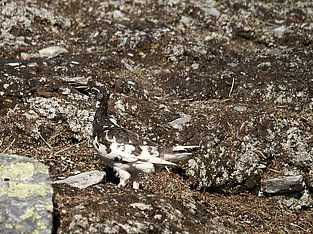
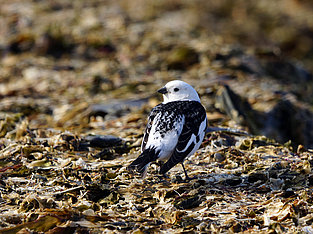
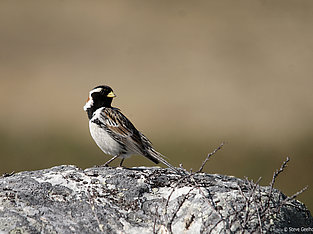
Karnovsky N. J. & M. V. Gavrilo (2017): A feathered perspective: the influence of sea ice on Arctic marine birds, In: D. N. Thomas (ed.), Sea Ice, 3rd edition, Wiley-Blackwell, Chichester (UK) Hoboken (NJ), pp. 556-569.
Peter H. U. (2014): Die Vogelwelt der Polarregionen und ihre Gefährdung, In: Lozán, J.L., H.Grassl, D.Notz & D.Piepenburg (2014): WARNSIGNAL KLIMA: Die Polarregionen. Wissenschaftliche Auswertungen, Hamburg, ISBN: 978-39809668-63, pp. 169-176.
Eamer, J., G. M. Donaldson, A. J. Gaston, K. N. Kosobokova, K. F. Lárusson, I. A. Melnikov, J. D. Reist, E. Richardson, L. Staples & C. H. von Quillfeldt (2013): Life Linked to Ice: A guide to sea-ice-associated biodiversity in this time of rapid change. CAFF Assessment Series No. 10. Conservation of Arctic Flora and Fauna, Iceland. ISBN: 978-9935-431-25-7.
Fijn R.C., D. Hiemstra, R. A. Phillips & J. van der Winden (2013): Arctic Terns Sterna paradisaea from The Netherlands migrate record distances across three oceans to Wilkes Land, East Antarctica. Ardea 101: pp. 3–12.
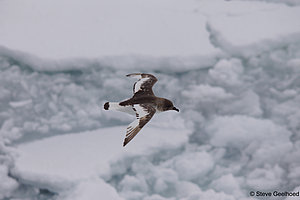
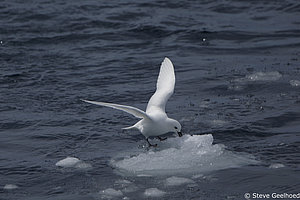
South of the Antarctic Convergence, the birds of the Antarctic can be divided into three main groups. Group 1 includes the sea-ice-associated species (“ice-dependent species”), which live with the ice year-round. Group 2 includes birds that live on the open sea and avoid the ice, while Group 3 includes those species that live on the open sea but tolerate the ice. In summer, they frequently gather near the ice margin all around the Antarctic continent, but don’t truly depend on the ice (David et al., 2017).
In the Southern Ocean south of 40°S, more than 130 species of flying seabirds from nine families have been classified in three orders (Ropert-Coudert et al., 2014). However, for many species there are only very few birds. The majority of Antarctic birds are true seabirds and spend most of their time on the water, which, with very few exceptions, is their also their food source. The families most representative of the sea-ice avifauna of the Antarctic are those belonging to the procellariiforms (Procellariiformes), which include albatrosses (Diomedeidae), petrels (Procellariidae) and diving petrels (Pelecanoides). The suliforms are an order of birds represented by the cormorants (Phalacrocoracidae). The order Charadriiformes is represented by the skuas (Stercorariidae) and to a lesser extent by gulls and terns from the family Laridae (Ropert-Coudert et al., 2014). A list of birds of the Antarctic can befound here. Throughout its annual cycle, the Antarctic petrel is closely linked to icebergs and/or open water, which follow the seasonal movements of the sea ice. In general, its hunting behaviour is closely bound to the sea ice, cold waters and ice floes. Accordingly, any change in the ice landscape can have direct impacts on the petrel population (Delord et al., 2020).
Four Antarctic species live in close contact with the sea ice year-round: the Antarctic petrel (Thalassoica antarctica), snow petrel (Pagodroma nivea), Adélie penguin (Pygoscelis adeliae) and emperor penguin (Aptenodytes forsteri). Their anatomies, physiologies and behaviours are highly adapted to living with the sea ice.
Perhaps the most characteristic birds of the Antarctic are the flightless penguins. They include the Adélie penguin (Pygoscelis adeliae) and emperor penguin (Aptenodytes forsteri). Although they are seabirds, in the following we will discuss penguins separately. Penguins lost the ability to fly as they evolved into highly specialised divers. Having adapted their wings into flippers, they are optimally suited for a life in the water. Their “underwater flying”, streamlined bodies and impressive dexterity while swimming and diving not only allow them to successfully hunt their main prey species (krill, fish and squid), but also to largely evade their main predators, the leopard seal and killer whale (Peter, 2014). They only come on land or on the ice for mating and moulting. Thanks to their dense bones and flipper-like wings, they can repeatedly dive to great depths, allowing them to use a far greater percentage of the water column than most other seabirds (Ropert-Coudert et al., 2014). The Adélie penguin (Pygoscelis adeliae) and emperor penguin (Aptenodytes forsteri) can also hold their breath for much longer than other species of comparable size living in the open water. As a result, they can cover considerable distances below the ice while hunting. This is especially advantageous in winter, when the phytoplankton – i.e., their food’s food – can only be found growing under the floes (Ainley et al., 2003).
Although penguins have adapted to the harsh living conditions in the Antarctic, they remain a challenge. Areas that lie far from any accessible watering holes, or remain covered in ice for extended periods during winter and spring, block penguins’ access to the water and food. However, especially after the energy-intensive breeding season, penguins have to replenish their fat reserves as quickly as possible. If the watering holes are far away, the birds have to cover great distances to reach the edge of the coastal ice. This can rapidly affect their breeding success.
The largest species are the 0.8- to 1-metre-tall emperor penguins, which return to their breeding sites on the Antarctic continent in the beginning of the southern winter in March / April. A penguin egg, which weighs ca. 450 g, is transferred from the female to the male. The male then incubates the egg on its feet, where it is protected by a feathered fold of skin, for 60–66 days out on the ice, at temperatures down to - 40 °C and wind speeds up to 200 km/h. The chick hatches in mid-July and is then fed and cared for by the returning female. The male – after having lost up to a third of its body weight over the four months since the start of the breeding season – now migrates to the open water to feed, and later returns with new food for its young (Peter, 2014). In 2009, the emperor penguin population was estimated at ca. 238,000 breeding pairs (Fretwell et al., 2012).
Aside from the emperor penguin, the Adélie penguin is the only penguin species to breed in groups on the Antarctic continent. Its colonies can be found on all of the continent’s coasts, as well as neighbouring islands. The Adélie penguin breeds in the southern summer, between October and March. The species is a highly sensitive indicator for the variability of physical and biological environmental parameters. Its ability to find food greatly depends on the sea-ice conditions (Ropert-Coudert et al., 2014). For these penguins, moderate sea-ice cover (ca. 15%) offers optimal winter conditions. In spring and summer, they chiefly hunt in the marginal ice zone, with 6 to 15% ice cover (Ainley et al., 2003). The Adélie penguin population in the Antarctic has been estimated at ca. 3,790,000 breeding pairs, ca. 50% higher than in estimates made 20 years earlier (Lynch and LaRue, 2014).
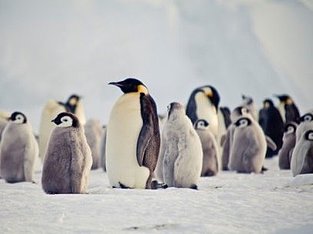
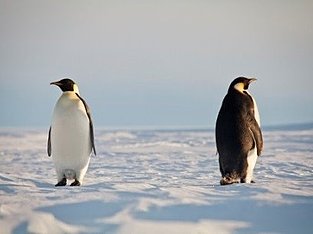
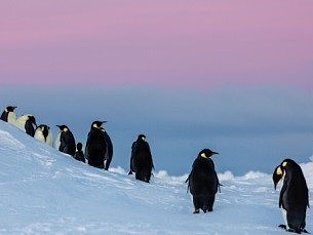
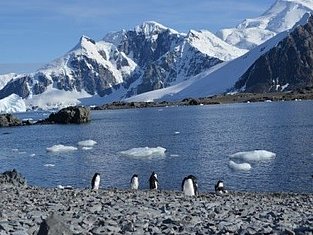
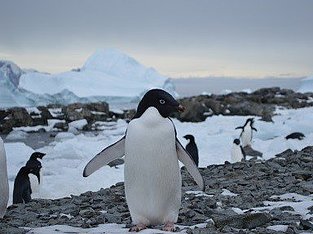
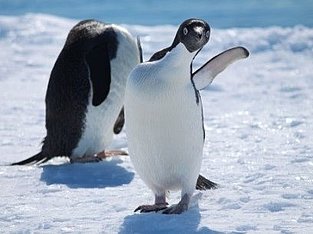
David, A., E. J. Woehler & A. Lescroël (2017): Birds and Antarctic sea ice, In: D. N. Thomas (ed.), Sea Ice, 3rd edition, Wiley-Blackwell, Chichester (UK) Hoboken (NJ), pp. 570-582
Delord, K., A. Kato, A. Tarroux, F. Orgeret, C. Cotté, Y. Ropert-Coudert, Y. Cherel & S. Descamps (2020): Antarctic petrels ‘on the ice rocks’: wintering strategy of an Antarctic seabirdR. Soc. open sci.7191429, doi.org/10.1098/rsos.191429
Fretwell P. T., M. A. LaRue, P. Morin, G. L. Kooyman, B. Wienecke & N. Ratcliffe N et al. (2012): An Emperor Penguin Population Estimate: The First Global, Synoptic Survey of a Species from Space. PLoS ONE 7(4): e33751. doi.org/10.1371/journal.pone.0033751
H. J. Lynch & M. A. LaRue (2014): First global census of the Adélie Penguin, The Auk, Volume 131, Issue 4, 1 October 2014, pp. 457–466, doi.org/10.1642/AUK-14-31.1
Peter, H. U. (2014: Die Vogelwelt der Polarregionen und ihre Gefährdung, In: Lozán, J.L., H.Grassl, D.Notz & D.Piepenburg (eds.): WARNSIGNAL KLIMA: Die Polarregionen. Wissenschaftliche Auswertungen, Hamburg. 376 pages. ISBN: 978-39809668-63, pp. 169-176
Ropert-Coudert, Y., M. A. Hindell, R. Phillips, J.-B. Charrassin, L. Trudelle & B. Raymond (2014): Birds and Mammals. In: de Broyer C, Koubbi P, Griffiths H, Raymond B et al. (eds) The Biogeographic Atlas of the Southern Ocean. Scientific Committee on Antarctic Research, Cambridge UK, pp. 364-387. ISBN: 978-0-948277-28-3
Ainley, D.G, C. T. Tynan & I. Stirling (2003): Sea ice: A critical Habitat for Polar Marine Mammals and Birds, In: D. N. Thomas (ed.), Sea Ice, 3rd edition, Wiley-Blackwell, Chichester (UK) Hoboken (NJ), pp. 240-266

